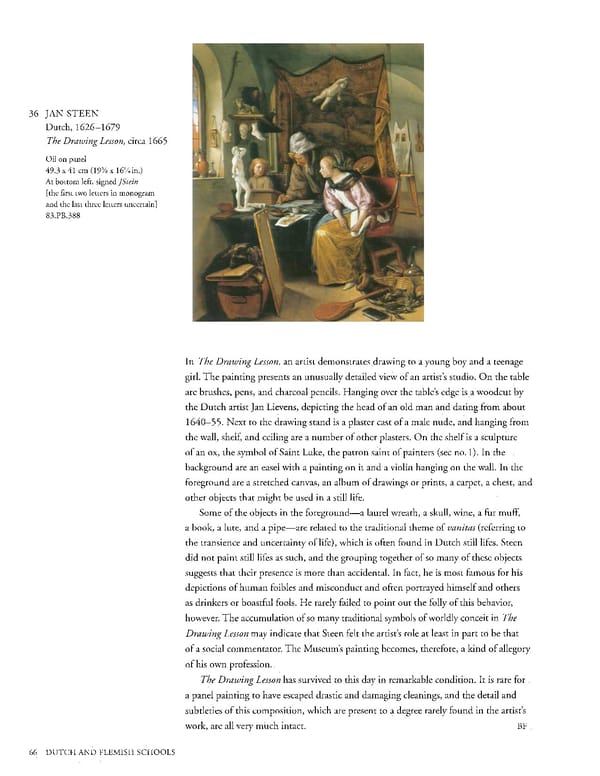36 JANSTEEN Dutch, 16261679 The Drawing Lesson, circa 1665 Oil on panel 3 49.3 x 41 cm (19/sx 161/4 in.) At bottom left, signed JStein [the first two letters in monogram and the last three letters uncertain] 83.PB.388 In The Drawing Lesson, an artist demonstrates drawing to a young boy and a teenage girl. The painting presents an unusually detailed view of an artist s studio. On the table are brushes, pens, and charcoal pencils. Hanging over the table's edge is a woodcut by the Dutch artist Jan Lievens, depicting the head of an old man and dating from about 164055. Next to the drawing stand is a plaster cast of a male nude, and hanging from the wall, shelf, and ceiling are a number of other plasters. On the shelf is a sculpture of an ox, the symbol of Saint Luke, the patron saint of painters (see no. 1). In the background are an easel with a painting on it and a violin hanging on the wall. In the foreground are a stretched canvas, an album of drawings or prints, a carpet, a chest, and other objects that might be used in a still life. Some of the objects in the foreground—a laurel wreath, a skull, wine, a fur muff, a book, a lute, and a pipe—are related to the traditional theme of vanitas (referring to the transience and uncertainty of life), which is often found in Dutch still lifes. Steen did not paint still lifes as such, and the grouping together of so many of these objects suggests that their presence is more than accidental. In fact, he is most famous for his depictions of human foibles and misconduct and often portrayed himself and others as drinkers or boastful fools. He rarely failed to point out the folly of this behavior, however. The accumulation of so many traditional symbols of worldly conceit in The Drawing Lesson may indicate that Steen felt the artist's role at least in part to be that of a social commentator. The Museum's painting becomes, therefore, a kind of allegory of his own profession. The Drawing Lesson has survived to this day in remarkable condition. It is rare for a panel painting to have escaped drastic and damaging cleanings, and the detail and subtleties of this composition, which are present to a degree rarely found in the artist's work, are all very much intact. BF 66 DUTCH AND FLEMISH SCHOOLS
 Masterpieces of the Getty Museum: Paintings Page 66 Page 68
Masterpieces of the Getty Museum: Paintings Page 66 Page 68